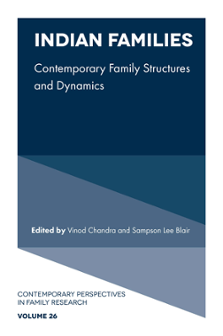Independence in partner selection
, 154
India
, 78, 85–86
arranged marital system in
, 159
cultural dimensions influence marriage and romance in
, 158–161
cultural significance of arranged marriage system in
, 159
family structure in
, 52–53, 99–100
gender differences in premarital sex in
, 165–166
impact of globalization on marital system of
, 163–164
historical introduction to marriage system in
, 152–158
nature of arranged marriage in
, 159–160
researches on intergenerational relationship in
, 104–105
technoscapes in
, 166–167
theoretical perspectives on marital change in
, 151
traditional patriarchal culture
, 98
women empowerment indicators in
, 81
zones in
, 88
Indian families
, 69, 72, 181–182, 202
from arranged marriage to love marriage
, 71
cases
, 141–144
changing size of
, 67–68
data and method
, 130–131
family and community
, 141
family relationships and social media
, 74
features of 21st-century Indian families
, 68–70
finalizing proposal
, 139–141
households and family
, 67–68
incidence of divorce and separation and family structure
, 71–73
initiating contact
, 134–136
inter-caste marriages
, 70–71
key findings of study
, 132
marriage and compatibility among youth
, 136–138
methodology of study
, 131
in online match making
, 129
personal vs. social attributes
, 132–134
review of literature
, 129–130
single-parent Indian Families
, 73–74
spousal expectations and choices
, 138–139
structure
, 52
system
, 150
transition from joint family system to nuclear family system
, 66–67
Indian Human Development Survey (IHDS)
, 156, 171
Indian marriage system
, 161
impact of globalization on marital system of India
, 163–164
scapes
, 162–163
Indian social organization
, 44
Indian society
, 36, 52, 66, 74, 98, 171
Indian young adults, premarital romance and sexual relationship among
, 164–167
Individual distress in premarital relationships
, 168
Information technology (IT)
, 130
Inter-spousal communication, fertility and
, 38–40
Interdependent society
changing trends in family structure
, 100
conceptual bases of intergenerational relation
, 101–103
correlations of consensual process, functional process, and normative process
, 111
economic class
, 119
family structure in India
, 99–100
intergenerational relationship and family structure in
, 100–101
location
, 117
mean and SD of coping strategies
, 110
mean and SD of dimensions of emotional experiences and intergenerational relation
, 110
mean and SD scores of consensual process, functional process, normative process
, 109
mean and SD Scores of subjective experiences and dimensions by total sample
, 109
method
, 107
perspectives of younger adults toward elderly
, 103–104
predictors of intergenerational ambivalence
, 113
predictors of intergenerational conflict
, 114–115
predictors of intergenerational solidarity
, 112
procedures
, 107
process of ambivalence
, 120–121
process of conflict
, 121
process of intergenerational relations
, 119
process of solidarity
, 120
rationale
, 106–107
researches on intergenerational relationship in India
, 104–105
result
, 107
role
, 118
sample
, 107
scale description
, 107–108
theoretical positioning
, 105–106
Intergenerational contacts
, 103–104
Intergenerational interaction
, 103–104
Intergenerational relations
, 102, 119
conceptual bases of
, 101
intergenerational ambivalence
, 102–103
intergenerational conflict
, 101–102
intergenerational solidarity
, 102
Intergenerational relationships
, 46, 101
in interdependent society
, 100–101
researches on intergenerational relationship in India
, 104–105
Intergenerational solidarity
, 110
